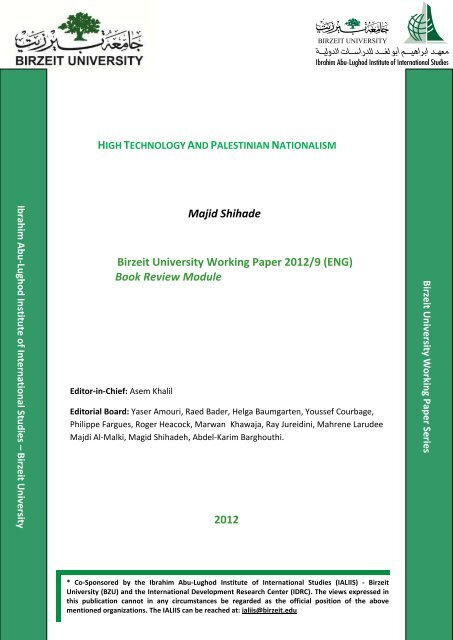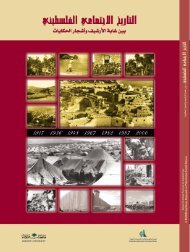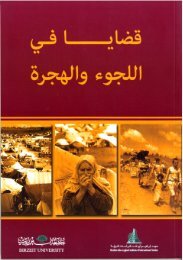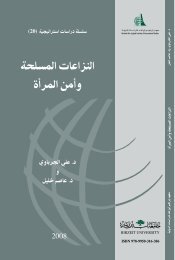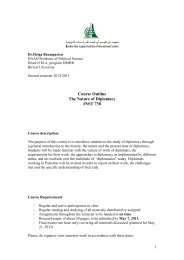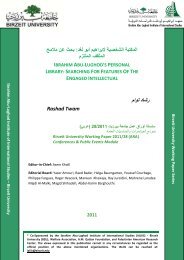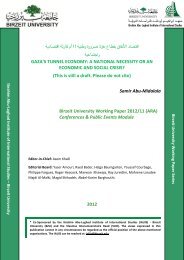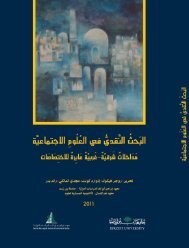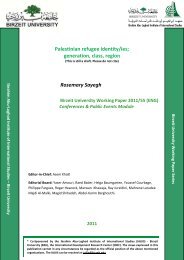Majid Shihade Birzeit University Working Paper 2012/9 (ENG) Book ...
Majid Shihade Birzeit University Working Paper 2012/9 (ENG) Book ...
Majid Shihade Birzeit University Working Paper 2012/9 (ENG) Book ...
Create successful ePaper yourself
Turn your PDF publications into a flip-book with our unique Google optimized e-Paper software.
Ibrahim Abu-Lughod Institute of International Studies – <strong>Birzeit</strong> <strong>University</strong><strong>Birzeit</strong> <strong>University</strong> <strong>Working</strong> <strong>Paper</strong> SeriesHIGH TECHNOLOGY AND PALESTINIAN NATIONALISM<strong>Majid</strong> <strong>Shihade</strong><strong>Birzeit</strong> <strong>University</strong> <strong>Working</strong> <strong>Paper</strong> <strong>2012</strong>/9 (<strong>ENG</strong>)<strong>Book</strong> Review ModuleEditor-in-Chief: Asem KhalilEditorial Board: Yaser Amouri, Raed Bader, Helga Baumgarten, Youssef Courbage,Philippe Fargues, Roger Heacock, Marwan Khawaja, Ray Jureidini, Mahrene LarudeeMajdi Al-Malki, Magid <strong>Shihade</strong>h, Abdel-Karim Barghouthi.<strong>2012</strong>* Co-Sponsored by the Ibrahim Abu-Lughod Institute 0 of International Studies (IALIIS) - <strong>Birzeit</strong><strong>University</strong> (BZU) and the International Development Research Center (IDRC). The views expressed inthis publication cannot in any circumstances be regarded as the official position of the abovementioned organizations. The IALIIS can be reached at: ialiis@birzeit.edu
High Technology and Palestinian Nationalism 1<strong>Majid</strong> <strong>Shihade</strong>Miriyam Aouragh (2011). PALESTINE ONLINE: Transnationalism, the Internet and Constructionof Identity. London and New York: I.B. Tauris, 2011. XX+234. Appendix to p. 236. Notes to p.248. Bibliography to p. 264. Index to p. 272, n.p. cloth.In Palestine Online, Aouragh discusses the use of internet technology among Palestinians basedon fieldwork in three different locations: Palestine in 2001-2, among Palestinian refugees inJordan in 2003, and in Lebanon in 2003-4 (p.30). Along with participant observations, sheinterviewed academics, internet café customers and owners, and some of those who lead theimplementation of new technologies in Palestine.In the book, Aouragh discusses how Palestinians use the internet while living in Palestine underIsraeli colonial rule or, having been expelled by the Israelis, in exile. It shows how the internet isused as a source of mobility to overcome the Palestinians’ state of immobility, and how theinternet as a space and instrument links the Palestinians in the West Bank and Gaza with thosein refugee camps in Jordan and Lebanon, despite their physical separation by state boundariesand travel restrictions. For Aouragh, it is about space and technology, which helps maintainand strengthen communication not just among Palestinians, but also with other globalaudiences (p.2).The book is divided into six chapters and an epilogue. Chapter one is focused on the role of theinternet in Palestine, and how it is used to communicate with the rest of the world as a tool ofa specifically Palestinian media. Chapter two highlights the tension between this virtualmobility, and physical immobility on the ground. Chapter three discusses how Palestinianimmobility created pressure for the emergence of internet initiatives to overcome immobility,occupation, exile, and forced migration. Chapter four examines the relationship betweenvirtual space and territorial place as they relate to national identity and nation state in theabsence of sovereignty, and how the events of 1948 structure memory and identity. Chapterfive is a study of Palestinian websites, and chapter six is a discussion of everyday use of internettechnologies and internet cafés.These “…multi sited ethnographies makes [sic] clear that Palestine, as one nation, effectivelyexists in multiple states; it…also propagates the narratives of discontent, contrasting the falseportrayals…” (p.2). Not only does this technology strengthen connections among Palestinians in1 This <strong>Book</strong> Review was first published by Journal of Palestine Studies. Vol. XLI, No. 2: 128-129.1
different localities, but it is also able to counter Israeli and western media misinformation andpropaganda about the Palestinians. In this way, new technologies help to democratize andhumanize the mainstream narratives, which often work in line with Israeli propaganda todehumanize the Palestinians, and repress the facts of criminal Israeli practices, while denyingthe western-backed Israeli role in Palestinian repression, dispossession, and displacement.One of the drawbacks of the book is the large number of theoretical references, which aremore akin to name-dropping than actually grounding those concepts in the work, and does notadd to the issues discussed. Furthermore, there is much repetition throughout the book whichmakes it tiresome to read. Another issue is how the category of Palestine came to representonly those in the West Bank, Gaza, and refugee camps in Lebanon and Jordan, withoutdiscussing the linkages these Palestinians have with their fellow Palestinians in Jerusalem, inthe Galilee, and elsewhere. In a sense, this limited application strengthens the alreadywidespread understanding that Palestine only denotes the territories colonized by Israel in1967 and the refugees. Finally, the author, by speaking on the uses of internet among Muslimsand how Islam and Muslim clerics look at this technology, while partially relying on work doneon the Gulf, contributes to the particularizing of Islam and Muslims’ attitudes towards internetuse (see for example on p. 220), and generalizing from studies of Gulf Muslims to Muslims inother parts of the world, while similar debates on the benefits and costs of the internet takeplace all around the globe.Still, despite these drawbacks and the need for a more reflexive anthropology, the book isuseful in its reflection on the use of internet technology by Palestinians and the proliferation ofmailing lists, news’ blogs, and websites in the face of Israeli wars, dehumanization, and denial,and how this technology has been used to counter this reality and provide an alternativesource of information and build linkages among the Palestinians.2


